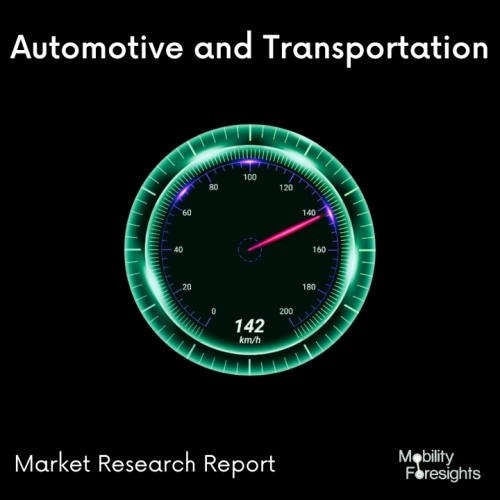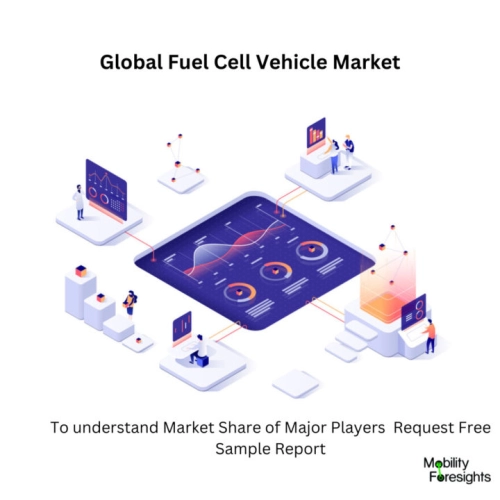
- Get in Touch with Us

Last Updated: Apr 25, 2025 | Study Period: 2023-2030
A fuel cell vehicle (FCV) is an innovative and environmentally friendly transportation solution that uses fuel cells to generate electricity and power the vehicle. Unlike traditional fossil fuel-powered vehicles, FCVs run on hydrogen, a clean and abundant source of energy. The introduction of FCV cars is a significant step towards sustainable and emission-free transport and offers many benefits for both the environment and consumers.
At the heart of the FCV is a fuel cell stack consisting of individual fuel cells that chemically convert hydrogen and oxygen into electricity, water and heat through an electrochemical reaction. This electricity powers the electric motor that propels the vehicle forward. The only byproduct of this reaction is water vapor, which makes FCV emission-free and environmentally friendly.
One of the main advantages of FCVs is their emission-free nature. Using hydrogen as a fuel source, FCVs do not produce harmful pollutants such as carbon dioxide (CO2), nitrogen oxides (NOx) or particulate matter. This feature helps reduce air pollution and mitigate the harmful effects of greenhouse gasses on climate change.
In addition, FCVs offer several advantages over traditional electric vehicles (EVs) that use rechargeable batteries. One big advantage is the significantly shorter refill time of the FCV compared to the hours required to charge the battery. Fueling an FCV with hydrogen takes the same amount of time as fueling a regular gasoline vehicle, typically about 3-5 minutes.
This quick refueling feature improves comfort and eliminates travel anxiety, enabling longer rides without compromising comfort. Another advantage of FCVs is their longer range. Because the energy density of hydrogen is much higher than that of batteries, FCVs can travel longer distances on a single tank of hydrogen compared to electric vehicles on a single battery charge.
This expanded range makes the FCV more suitable for long-distance journeys and reduces the need for frequent fuel stops, offering drivers more flexibility and comfort. In addition, FCV cars have high energy efficiency. Fuel cells have the potential to achieve higher efficiency compared to internal combustion engines because they convert chemical energy directly into electricity without mechanical transformations. Increased efficiency reduces energy consumption, resulting in lower operating costs for FCV owners.
The development and deployment of FCV also promotes diversification of energy sources and energy security. Hydrogen, the primary fuel for FCVs, can be produced from a variety of sources, including renewable energy such as solar and wind, and processes such as electrolysis. Such versatility in fuel production ensures a more sustainable and sustainable energy infrastructure, reduces dependence on fossil fuels and promotes energy independence.
Although FCVs have many advantages, there are also challenges that need to be addressed for their widespread adoption. The main problem is the availability of hydrogen refueling, as it is limited in many regions. However, governments and industry stakeholders are actively working to expand the hydrogen infrastructure network to support the growth of FCVs.
In short, it can be stated that fuel cell vehicles are a promising and environmentally friendly transport solution. Using hydrogen fuel cells to generate electricity, FCVs offer emission-free operation, longer driving distances, quick refueling times and high energy efficiency.
These vehicles play a vital role in reducing air pollution, curbing climate change and diversifying energy sources. With the continued development of fuel cell technology and the expansion of hydrogen infrastructure, FCVs have the potential to revolutionize the transportation industry and promote a more sustainable future.

The Global Fuel Cell Vehicle Market accounted for $XX Billion in 2022 and is anticipated to reach $XX Billion by 2030, registering a CAGR of XX% from 2023 to 2030.
Toyota Mirai:
The Toyota Mirai is a fuel cell electric vehicle (FCEV) that first appeared in 2014. It is powered by a hydrogen fuel cell that produces electricity to power the vehicle's electric motor. The Mirai has a range of over 300 miles on a single tank of hydrogen and can be refilled in minutes.
Mirai's fuel cell works by combining hydrogen and oxygen to produce electricity. Hydrogen is stored in a high-pressure tank and oxygen is sucked from the air. A fuel cell transforms the chemical energy of hydrogen and oxygen into electrical energy that powers the vehicle's electric motor.
Hyundai Nexo:
Hyundai Nexo is another FCEV that was launched in 2018. It has a range of over 400 miles on a single tank of hydrogen and can be refilled in just five minutes. The Nexo is also more efficient than the Mirai and has lower emissions.
The Nexo's fuel cell works the same way as the Mirai. However, Nexo has a different type of fuel cell that is more efficient and produces fewer emissions. The Nexo also has a larger hydrogen tank, which gives it a longer range.
Honda Clarity fuel cell:
The Honda Clarity Fuel Cell is an FCEV that was released in 2016. It has a range of over 300 miles on a single tank of hydrogen and can be refilled in minutes.
The Clarity Fuel Cell is also more affordable than the Mirai and Nexo.The Clarity Fuel Cell works in the same way as the Mirai and Nexo. However, the Clarity Fuel Cell is cheaper to produce, making it more affordable for consumers.
BMW i Hydrogen Next:
The BMW i Hydrogen Next is an FCEV that is expected to be released in 2022. It has a range of more than 400 miles on a single tank of hydrogen and can be refilled in just five minutes. i Hydrogen Next is also more efficient than Mirai, Nexo and Clarity Fuel Cell.
i Hydrogen Next's fuel cell works similarly to the other FCEVs on this list. However, i Hydrogen Next uses a new type of fuel cell that is more powerful and efficient. The i Hydrogen Next also has a larger hydrogen tank, giving it a longer range.
| Sl no | Topic |
| 1 | Market Segmentation |
| 2 | Scope of the report |
| 3 | Abbreviations |
| 4 | Research Methodology |
| 5 | Executive Summary |
| 6 | Introduction |
| 7 | Insights from Industry stakeholders |
| 8 | Cost breakdown of Product by sub-components and average profit margin |
| 9 | Disruptive innovation in the Industry |
| 10 | Technology trends in the Industry |
| 11 | Consumer trends in the industry |
| 12 | Recent Production Milestones |
| 13 | Component Manufacturing in US, EU and China |
| 14 | COVID-19 impact on overall market |
| 15 | COVID-19 impact on Production of components |
| 16 | COVID-19 impact on Point of sale |
| 17 | Market Segmentation, Dynamics and Forecast by Geography, 2023-2030 |
| 18 | Market Segmentation, Dynamics and Forecast by Product Type, 2023-2030 |
| 19 | Market Segmentation, Dynamics and Forecast by Application, 2023-2030 |
| 20 | Market Segmentation, Dynamics and Forecast by End use, 2023-2030 |
| 21 | Product installation rate by OEM, 2023 |
| 22 | Incline/Decline in Average B-2-B selling price in past 5 years |
| 23 | Competition from substitute products |
| 24 | Gross margin and average profitability of suppliers |
| 25 | New product development in past 12 months |
| 26 | M&A in past 12 months |
| 27 | Growth strategy of leading players |
| 28 | Market share of vendors, 2023 |
| 29 | Company Profiles |
| 30 | Unmet needs and opportunity for new suppliers |
| 31 | Conclusion |
| 32 | Appendix |